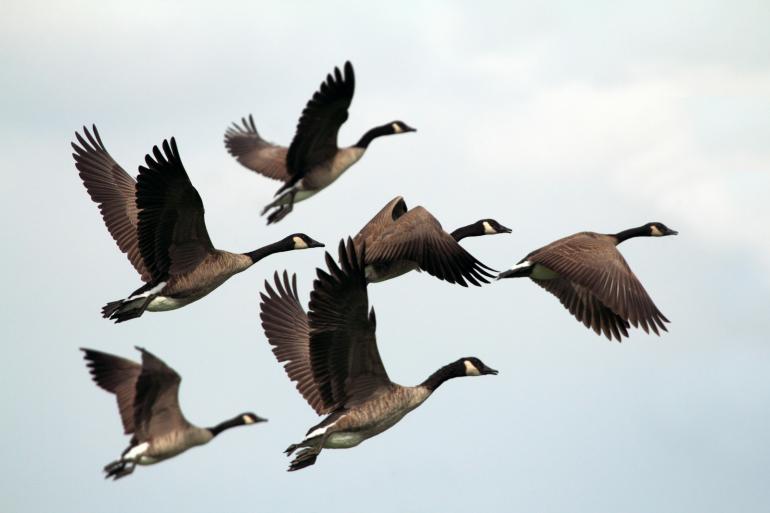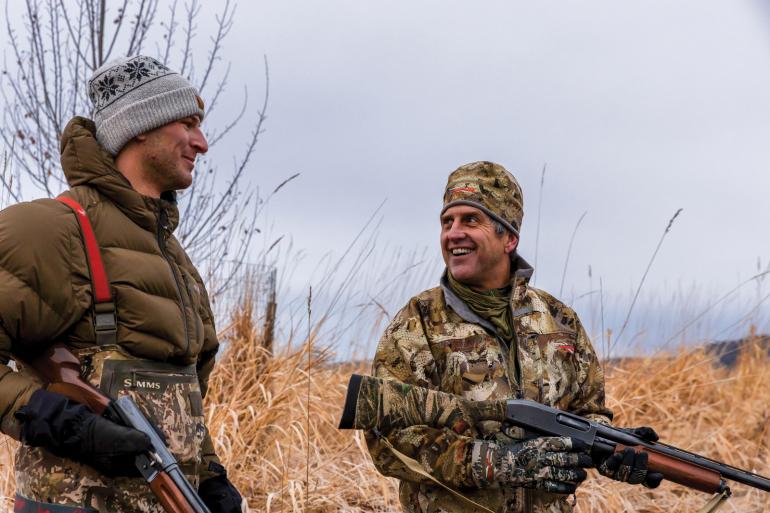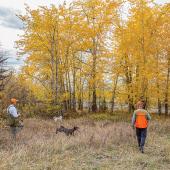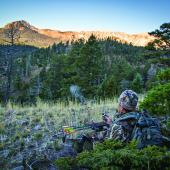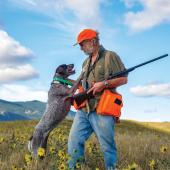Geese Lightning
The ins and outs of Montana goose hunting.
Sun broke the horizon and cast an expansive orange glow across the prairie. We were holed up in a stubble field with dozens of hard-shell decoys scattered among us. It was cold, but now that light had finally arrived, we sensed what it was like to be warm again. Then we heard them. A chorus of high-pitched honks rang through the morning quiet as tiny black flecks rose in the distance. As they neared, we sang back, imitating their calls and inviting them into the set. Seven split from the main flock and circled us twice. On the third lap, they dropped elevation to what couldn’t have been higher than ten yards. “On the deck,” as they call it. In a V-formation, their wings hung outstretched as they prepared to land. You couldn’t draw it up better than this. Take ’em!
Habitat
In this scene, I was miles from the closest water source—and setting up a field shoot for geese requires some homework. To state the obvious, geese, like other waterfowl, live near water. Typically, the bigger and slower the water, the better. On a calm day, they’ll hang out in the middle of Canyon Ferry. But that doesn’t happen very often, so they’ll frequently be tucked away closer to shore in coves that offer protection from the wind.
They also need reliable food sources nearby, which in Montana means farm fields. To find geese, look for a grain field within a mile or two of a lake, pond, or river. Females will nest in areas of thicker cover such as grassy islands, or even sagebrush. But generally, geese don’t seek out dense vegetation in which to spend their time. Instead, they rely on their eyes and ears to spot threats from far away, which can prove frustrating during hunting season.
Canada geese are most active in the morning and evening when it’s time to eat. If the weather is warm and calm, it’s not uncommon for them to sit on the water all day save for flights at dawn and dusk.
Behavior
There are two types of goose species in Montana: Canada geese and snow geese. Both are migratory, but snows do not live here year-round. Catching the snow-goose migration in the spring or fall is a timely effort. They’ll often make a stop at Freezeout Lake to rest and recover for a day or two. But if the lake is frozen when they come through, they’ll continue their journey and the only shot of seeing them is when they’re cruising a mile high for a week in November and April.
Canada geese migrate as well, but some birds stay in Montana year-round. They’re most active in the morning and evening when it’s time to eat. If the weather is warm and calm, it’s not uncommon for them to sit on the water all day save for flights at dawn and dusk. That’s what makes bad weather so good for waterfowl hunting.
As mentioned, executing a solid goose hunt requires some planning—no matter what tactics are used. If you’re setting up on the water, scout for back eddies or hidden sloughs. Do this ahead of time. Same goes for a field set. Geese have fields they return to day after day, sometimes year after year. Instead of picking a random plot of grain to lay your decoys in, take a morning to scout. Bring coffee, binocs, and a full gas tank. Glass them in the air and track them to their food source. If you have time, return that evening and see if the birds are in the same spot.
While some ag fields are state land and publicly accessible, most aren’t. This is a chance to continue cultivating good relationships between hunters and private landowners. And because geese don’t carry the eminence of big-game critters like elk, your odds of gaining access are better. Just remember the basics: be polite, humble, and offer something in return.
Gear
If you’re just starting out, find a buddy to take you on your first few outings. Waterfowl gear can add up quick, and if you find out it’s not your thing, there’s no reason to buy heaps of decoys you’ll only use once per year. What you can get right away that won’t break the bank is a goose call and a lanyard. Having it around your neck will prove its weight in gold during the occasional flyby.
Unless you’re doing strictly field shoots, get gear to keep you dry while walking through water.
While plenty of birds have been victim to the 20-gauge, it’s best to use a 12- or even 10-gauge for geese. These are big, fast-flying creatures, and they’re often farther away than you think. Use shot size BB or BBB, and bring plenty with you.
Unless you’re doing strictly field shoots, get gear to keep you dry while walking through water. A good muck boot is sufficient in shallow water, but hip boots or waders are preferred.
Regs
Waterfowl season begins in October and lasts into January. Montana has two migratory flyways: Central and Pacific. Though it doesn’t impact the bag limits for geese, it’s important to read up on the specifications for each, especially because one typically hunts ducks and geese at the same time. The daily limits for 2024 are five dark geese and 20 white geese. As always, consult FWP’s regs before heading out.
Corey Hockett grew up hunting in Montana and is the former managing editor of Stalk.


